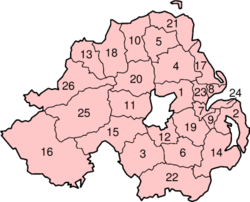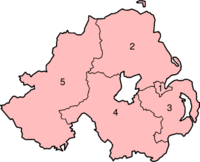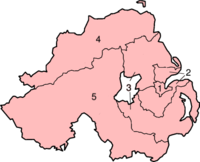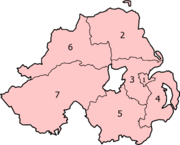Local government in Northern Ireland
2008/9 Schools Wikipedia Selection. Related subjects: UK Politics & government
Northern Ireland is divided into 26 districts for local government purposes. The councils do not carry out the same range of functions as those in the rest of the United Kingdom, e.g. they have no responsibility for education, for road building or for housing (though they do nominate members to the advisory Northern Ireland Housing Council). Their functions do include waste and recycling services, leisure and community services, building control and local economic and cultural development. They are not planning authorities, but are consulted on some planning applications. Collection of rates is handled by the Rate Collection Agency.
The council of the districts are variously styled 'District Council', 'Borough Council', 'City Council' and 'City and District Council' - see the articles for the full name.
Districts
|
|
History
The current pattern of local government in Northern Ireland, with 26 councils, was established in 1973 by the Local Government (Boundaries) Act (Northern Ireland) 1971 and the Local Government Act (Northern Ireland) 1972 to replace the previous system established by the Local Government (Ireland) Act 1898. The system is based on the recommendations of the Macrory Report, of June 1970, which presupposed the continued existence of the Government of Northern Ireland to act as a regional-level authority.
Elections
Councillors are elected for a 4-year term of office under the Single Transferable Vote (STV) system. Elections were last held in May 2005. In order to qualify for election, a councillor candidate must be:
- at least 21 years of age, and
- a British, Commonwealth, Irish or European Union citizen.
In addition, they must either:
- be a local elector for the district, or
- have, during the whole of the 12-month period prior to the election, either owned or occupied land in the district, or else resided or worked in the district.
For local government purposes, Northern Ireland was previously divided into six administrative counties and two county boroughs, with various rural districts and urban districts in the counties. This system, with the abolition of rural districts, remains the model for local government in the Republic of Ireland. See: List of rural and urban districts in Northern Ireland for more details.
Combinations
The districts are combined for various purposes. There are five Education and Library Boards in Northern Ireland, as follows
There are four Health and Social Services Boards
In the Eurostat Nomenclature of Territorial Units for Statistics (NUTS), Northern Ireland is divided into five parts at level 3
Future local government reform
Compared to unitary authorities in England, the Northern Ireland districts have small populations (average population of about 65,000).
The district structure and the structure of other areas of public services in Northern Ireland were reviewed by the Review of Public Administration. On 22 November 2005 Peter Hain, the Secretary of State for Northern Ireland, announced proposals to reduce the number of councils to seven . Although (outside Belfast) this is the same as the number of traditional counties of Northern Ireland, the borders were set just about as different to those of the counties as Northern Ireland's geography permits in order to ensure a fairer distribution of population.
The new authorities were to have a number of new powers in such areas as planning, local roads functions, regeneration, and fostering community relations, which were to be transferred from the existing joint boards and other bodies, that are much closer in size to the proposed local authorities. Legislation was to be introduced to prevent serving councillors also being Members of the Northern Ireland Assembly (the so-called dual mandate that was also recently abolished in the Republic).
Initital reaction from Northern Ireland's political parties, except for Sinn Féin, was hostile, emphasising the reduction in local representation and frequently expressing a fear that the province would be carved up on sectarian lines. Areas 2, 3 and 4 would have substantial Protestant, and 5, 6 and 7 Catholic majorities, with Belfast very nearly equally balanced. Former Secretary of State for Northern Ireland, Paul Murphy, criticised the proposals as too severe.
Another issue was where to place the District Headquarters of each district, with many towns hoping to be the headquarters of their districts.
The Local Government (Boundaries) (Northern Ireland) Order 2006 was made on May 9, 2006 providing for the appointment of a Local Government Boundaries Commissioner to recommend the boundaries and names of the seven districts and the to divide the districts into wards. Dick Mackenzie was appointed as Commissioner on July 1, 2006.
The commissioner announced his provisional recommendations on November 7, 2006:
Belfast - as present, plus Belvoir, Braniel, Castlereagh (not the borough), Cregagh, Gilnahirk, Glencregagh, Merok, Tullycarnet and Wynchurch (all from Castlereagh) and Colin Glen, Dunmurry, Kilwee, Lagmore, Poleglass and Twinbrook (all from Lisburn)
North East - Ballymena, Ballymoney, Coleraine (apart from Benone Strand), Larne (minus Whitehead Golf Club) and Moyle
Inner East - Antrim, Carrickfergus, Lisburn (apart from Colin Glen, Dunmurry, Kilwee, Lagmore, Poleglass and Twinbrook) and Newtownabbey plus the rest of Whitehead Golf Club
East - Down, Ards, Castlereagh (apart from Belvoir, Braniel, Castlereagh, Cregagh, Gilnahirk, Glencregagh, Merok, Tullycarnet and Wynchurch), North Down
South - Armagh, Banbridge, Craigavon, Newry and Mourne
North West - Derry, Limavady, Magherafelt, Strabane plus the rest of Benone Strand.
West - Cookstown, Dungannon and South Tyrone, Fermanagh, Omagh
An eight week public consultation period on the proposals, during which members of the public could make written submissions, ended on January 5, 2007. Public hearings conducted by assistant commissioners were held in January and February 2007. The assistant commissioners issued reports on the results of the hearings, and the commissioner published revised recommendations on March 30, 2007. There were only minor changes to the original scheme. The most controversial aspects of the proposed reform were the names of the new districts. However, as there was no consensus on the issue, it was to be to left to the elected councils to submit proposals to the Department of the Environment. The commissioner was due to make his final recommendations by May 31, 2007. It was envisaged that there will be elections to the new councils on May 5, 2009.
Review by Executive
In June 2007, following the restoration of a power-sharing Executive, it became clear that the plan to create seven "super-councils" was to be reviewed, if not abandoned. In July, Arlene Foster, Minister for the Environment in the Executive, announced a review. A committee was established which it is hoped will report by the end of 2007. The new review is likely to mean that the present structure will continue unchanged until 2011.




